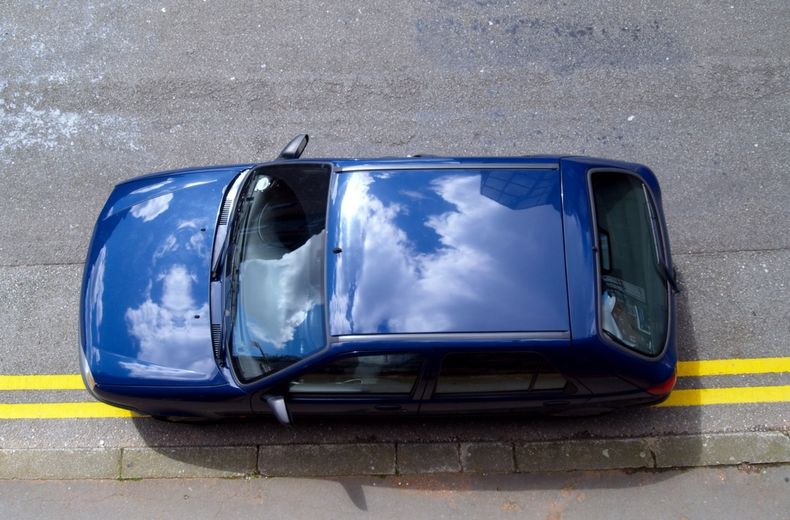Finding a parking space can be hard enough, let alone worrying about all of the potential restrictions that come with it.
To avoid a parking nightmare, read our simple guide to where you can and can't park.
General parking (the basics)
Of course, the most obvious place to park would be in a designated parking bay, either in a car park or at the side of the road.
These will be marked by a large white ‘P’ on a blue background, usually alongside the parking area and on directional signage.
Some parking bays will be free, while others will need to be paid for and some might have restrictions for what type of vehicle can park there.
There may also be restrictions on time limits or exclusions for those without permits - it's always worth checking the signs for more information before leaving your car.
Did you know?
You must park entirely within the white lines, or you run the risk of receiving a fine. If your vehicle is too large, that’s not an excuse, you’ll have to find an alternative space.
If you commit a parking offence on private land or in a car park which is operated by a private organisation on behalf of a landowner - such as in a supermarket or shopping centre - you will receive a Parking Charge Notice, not a Penalty Charge Notice.
The difference being a Parking Charge Notice isn’t enforced by the local highways authority or the police.
Click here to read our guide to Parking Charge Notices and how to avoid and appeal them.

Cheaper than AA or we’ll beat by 20%^
• Roadside cover from £5.49 a month*
• We get to most breakdowns in 60 mins or less
• Our patrols fix 4/5 breakdowns on the spot

Where can and can't you park?
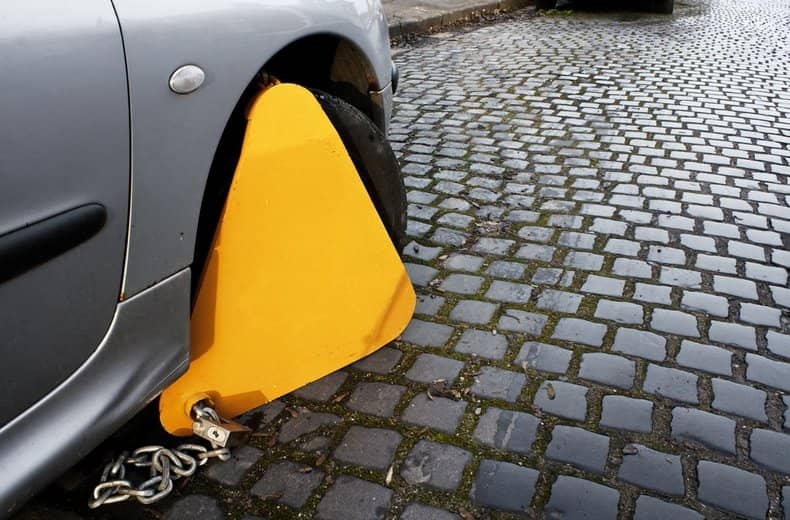
Parking outside of a car park is sometimes the only resort, but can be a minefield if you don't know the rules - here we look at where you can and can't park and what time restrictions might apply.
Double yellow lines
A double yellow line – either painted on the road or on the kerb – means parking and waiting are not permitted at any time.
In some cases, there might be seasonal restrictions, which will be indicated by signs at the roadside.
Loading and unloading may be permitted, providing you can be seen doing so continuously - unless there are specific restrictions against it, indicated either by signage or yellow 'kerb dashes'.
Blue Badge holders can park on single or double yellow lines for a maximum of three hours, providing there isn't signage to say otherwise, it is safe to do so and it is not causing an obstruction for other drivers.
Parking on double yellow lines fine
A double yellow line parking fine is usually £70 and is reduced by 50% if paid within 14 days. This, however, may vary depending on the local authority.
Single yellow lines
A single yellow line – either painted on the road or on the kerb – means no waiting, parking, loading or unloading at the times shown on the accompanying sign.
The restrictions tend to be lifted during evenings and weekends, but check the sign before parking.
The same as on double yellow lines, Blue Badge holders can park on single lines for a maximum of three hours, providing there isn't signage to say otherwise, it is safe to do so and it is not causing an obstruction for other drivers.
Red Route stopping controls
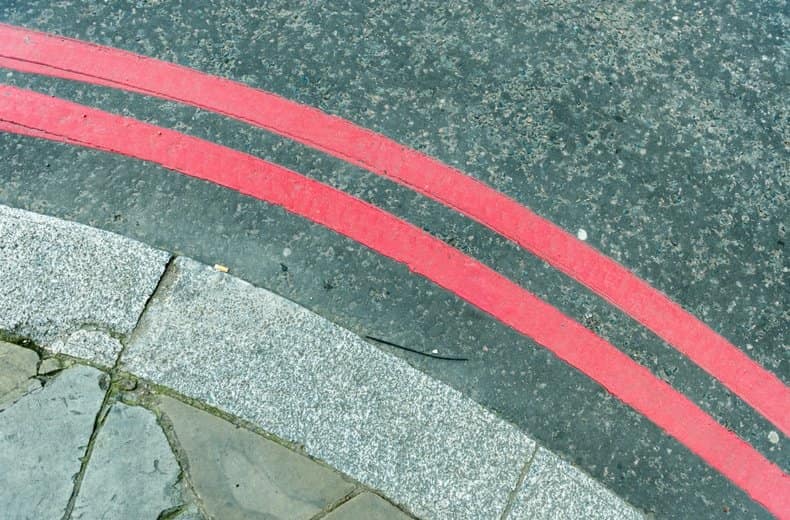
In some cases, red lines are used instead of yellow lines.
In London, the double and single red lines used on Red Routes indicate that stopping to park, load, unload, or to board and alight from a vehicle is prohibited, except for licensed taxis and Blue Badge holders.
The times that the red line restrictions apply will be shown on nearby signs, but a double red line means no stopping at any time.
One some Red Routes, you may stop to park, load or unload in specially marked boxes at times and for purposes specified by nearby signs.
For example, a Red Route might allow parking between the hours of 7am and 7pm, for one hour, with no return within two hours.
Note: red and yellow lines only provide a guide to the restrictions and drivers are advised to refer to signs for more information.
Clearways
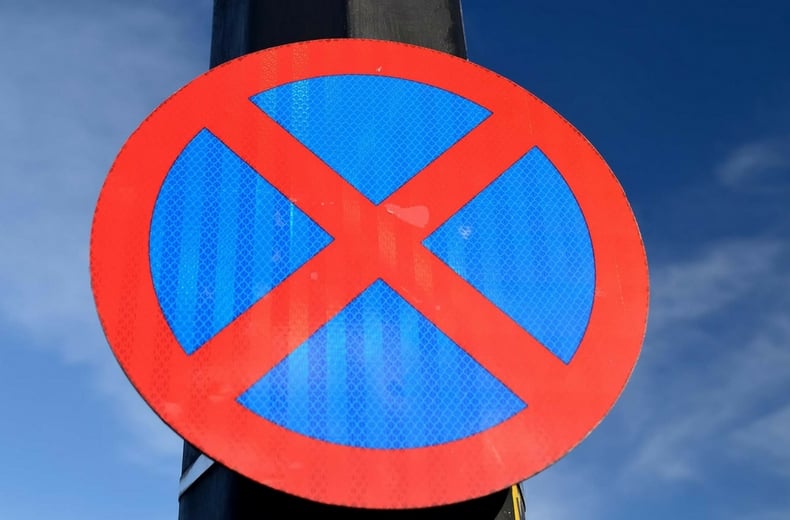
A red cross over a blue background is used to indicate a clearway, which means no stopping at any time – not even to pick up or set down passengers.
The sign is used to indicate a 24-hour clearway and might be incorporated into other signs with the words ‘No Stopping’.
There will be a sign at the start of the clearway, with a note about its length, i.e. ‘For 7 miles’. You won’t find special road markings on a clearway, but there should be smaller, repeater signs at one-mile intervals.
- Parking on the pavement - is it illegal?
- 11 of the most annoying driving habits
- Are you a middle lane hogger? Here are the facts
Loading bays
A loading bay will be marked by a dotted white line surrounding it, along with the words ‘Loading Only’ painted on the road.
These loading bays might be reserved for use by goods lorries or may be used by all vehicles, i.e. outside shops where heavy purchases have to be carried to a car. These bays should not be used before purchase, but only for the collection of pre-paid items.
Parking reserved for vehicles named
When parking is reserved for a specific type of vehicle or user, the bay will be marked by a dotted line and the name of the user painted on the road.
This might be a doctor, ambulance, disabled user or even a car club.
Increasingly, you may also find parking reserved for electric vehicles, which will be marked as ‘Electric Vehicles Only’ or a car and plug icon.
Yellow zig-zag lines
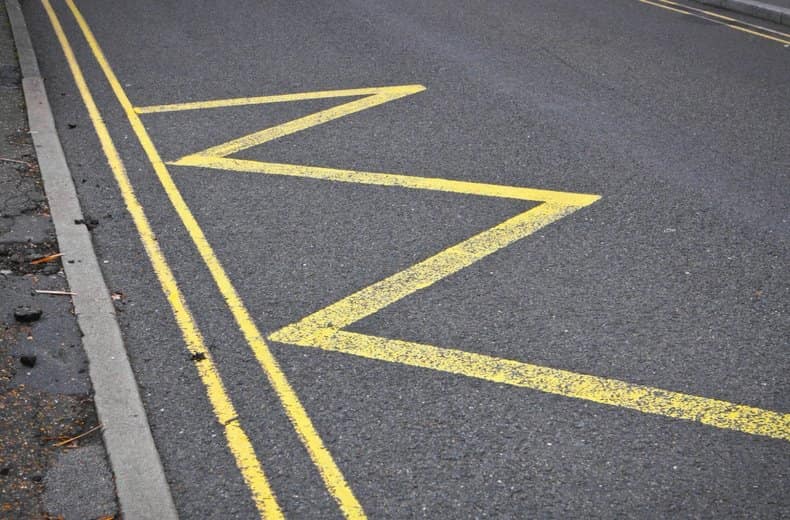
Yellow zig-zag lines outside schools, hospitals, or fire, police or ambulance stations indicate the length of road where stopping or waiting is strictly prohibited.
The Highway Code states that you should keep these areas clear of stationary vehicles, even if picking up or setting down children.
You may also find an upright sign, indicating a mandatory prohibition of stopping during the times shown.
White zig-zag lines
The approach to, and exit from, a pedestrian crossing is marked with white zig-zag lines.
Drivers must not park or overtake in this area, as parking would block the view for pedestrians and oncoming traffic.
In summary, you risk a fine and penalty points by parking on yellow or white zig-zag lines, but yellow zig-zags needs an accompanying sign to be legally enforceable.
White lines, on the other hand, are enforced by local authorities and the police, and they do not require a sign to be enforceable.
Parking outside someone’s house
It is perfectly legal to park outside someone’s house, unless the vehicle is blocking a driveway or a wheel is over a dropped kerb. Where no parking controls exist, drivers do not have an ‘automatic spot’ for parking outside their homes.
If your vehicle is on your driveway and another car is parked on a public highway and blocking your access out of your driveway, the council has the power to act. But if that other car is on a drive, it’s technically on private property – and the council has no authority to remove it.
Other situations in which parking isn’t permitted include streets governed by residents’ parking permits or any of the restrictions outlined above, i.e. double yellow lines.
Parking on the pavement
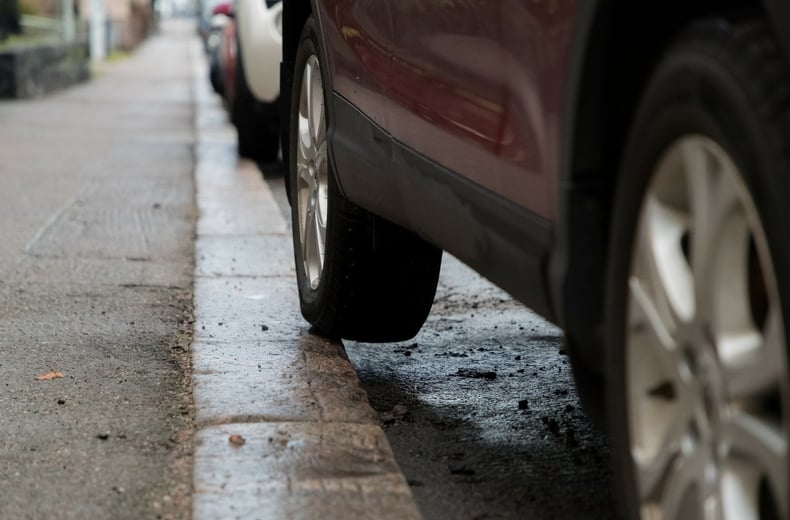
The Highway Code states that you must not park partially or wholly on the pavement in London and Scotland, and should not do elsewhere unless signs permit it.
Parking on a pavement can obstruct and inconvenience pedestrians, people in wheelchairs, those with visual impairments, and people with prams and pushchairs.
The key here is ‘must not’ and ‘should not’.
In other words, offenders in London and Scotland are committing a punishable offence and are liable to receive a parking ticket.
Elsewhere, drivers aren’t necessarily committing an offence, but it is an offence to drive on the pavement.
This means the law is a little fuzzy, as outlined by the Ask The Police website. It says: “Despite the obvious inference that a parked vehicle has been driven on the pavement prior to being parked there, witnesses to the driving will probably be needed to secure a prosecution - this can be problematic.”
If parking on the pavement is permitted, it will be marked by a blue and white sign.
If the car is wholly on the pavement, then vehicles may be parked entirely on the verge or footway.
If the car is half on the pavement, vehicles may be parked partially on the verge or footway.
Outside of London and Scotland, we advise people to use common sense when faced with no other option but to park on the pavement.
If you are parking along a narrow road, where parking wholly on the road would stop other cars, and particularly emergency vehicles, from getting through, then it is a sensible option to park partially on a pavement, providing there are no parking restrictions and providing you are not blocking a wheelchair user or pram from using the pavement.
If there are restrictions, or your parking would cause wheelchair users or people with prams to have to walk into the road, then you should find somewhere else to park.
Parking on the road - what the Highway Code says
The Highway Code isn't the law, but many of its rules are in fact legal requirements under the Roads Traffic Act, which you can be prosecuted for contravening.
You may be fined, given penalty points on your licence, disqualified from driving, or even sent to prison.
Here's what the Highway Code says for parking on the road:
- Do not park facing against the traffic flow
- Stop as close as possible to the roadside
- Do not park too close to a vehicle displaying a Blue Badge
- The engine, headlights and fog lights must be switched off
- The handbrake must be applied before leaving the car
- You must look out for other road users when you open your door
- Passengers should exit the vehicle on the side next to the kerb
- Valuables should be out of sight and the car locked
Parking lights must be used on a road or layby on a highway with a speed limit higher than 30mph.
Check your vehicle’s handbook to find out how to operate them: often, they are engaged by clicking the indicator stalk either left or right as you leave the car, but some models have dedicated parking light buttons.
Parking zones
The British Parking Association (BPA) outlines four different types of parking zones in the UK, namely:
Controlled Parking Zone (CPZ)
This is where waiting and loading is restricted for some or all of the time. Local authority websites will have details of CPZs in operation in their area, along with details of who’s eligible for a permit and how to obtain one.
Restricted Parking Zone (RPZ)
This is where waiting and possibly loading restricted might be applied, even though there are no yellow lines. The times of operation will be stated on signs upon entry and within the zone.
Permit Parking Area (PPA)
This is an area in which you must have a stated type of permit to park during its hours of operation. You must display the permit, even though there are no parking bays or road markings.
Pedestrian Zones
These are areas that you must not enter during operational hours. Even outside these times, there might be loading and waiting restrictions, which will be stated on the bottom panel of the zone signs.
Look out for zones described differently, for example, ‘Meter Zone’, ‘Restricted Zone’ or ‘Pay & Display Zone’.
As a broader point, look out for seasonal variations, where restrictions might be lifted at certain times of the year.
This is especially true in tourist areas, where parking restrictions might not be in operation during the winter months.
Busy shopping areas can sometimes lift restrictions around Christmas and on Sundays: it pays to check.
MORE ADVICE: Motorway cameras - which ones can catch you out
18 places you cannot park
In addition to the points above, The Highway Code tells us you must not stop or park in the following locations, except when forced to do so by stationary traffic:
- Near a school entrance (see specific section above)
- Anywhere that would prevent access for emergency vehicles
- On a bus or tram stop, or a taxi rank
- On the approach to a level crossing
- Opposite or within 32 feet of a junction, except in an authorised parking bay
- Near the brow of a hill or humpback bridge
- Opposite a traffic island or another parked vehicle (if it causes an obstruction)
- Where you would force another vehicle to enter a tram lane
- Where the kerb has been lowered to help wheelchair and mobility vehicle users
- In front of an entrance to a property
- On a bend
- Where you would obstruct a cycle lane
- A tram or cycle lane during its period of operation
- A cycle track
- A pedestrian crossing, including the area marked by the zig-zag lines
- On the carriageway or the hard shoulder of a motorway (except in an emergency)
- Taxi bays (as directed by the upright signs and road markings)
- A road marked with central double white lines, even if a broken white line is on your side of the road, except for dropping off, picking up, loading or unloading
The penalties for illegal parking
The Traffic Management Act 2004 allows local authorities to control parking enforcement on yellow lines, resident parking, public car parks and on-street parking.
A Penalty Charge Notice (PCN) might be issued and enforced through the civil justice system, rather than the criminal justice system.
A fine may be either £70 or £50, depending on the impact of the offence.
For example, parking on a double yellow line will be at the higher rate of £70, whereas if a pay and display ticket has expired, the lower rate of £50 will apply.
Payment received within 14 days gets a discount of 50%.
Drivers who persistently ignore PCNs risk having their vehicle clamped and towed away, at which point the charges go up.
If you receive a parking ticket for parking on private land - read our Parking Charge Notice guide.
For more useful content like this sign up to our weekly newsletter
Want to protect yourself from any losses following an accident? Get legal expenses insurance from just £15 a year with RAC Legal Care Plus.
- RAC Temporary Car Insurance from 1 hour to 30 days
- RAC Learner Driver Insurance from 1 day to 5 months
Get 30 driving tips that will save you money
Running a car isn’t cheap, but there are some easy things you can do to keep your costs down. Get these tips and more useful driving articles sent straight to your inbox now.


Parking in the UK - FAQs
- How long can you park on a single yellow line UK?
In the UK, you can’t park on a single yellow line at any time of the day or night. The reason for this is that single yellow lines are in place to ensure the safe and smooth flow of traffic, and parking on a single yellow line would interfere with this. However, you are allowed to stop your vehicle for a short period of time in order to load and unload goods, or to pick up and set down passengers. This is usually limited to a maximum of 20 minutes, although this may vary in different areas.
It’s important to be aware that any parking restrictions that apply to yellow lines are always clearly signed. These signs will indicate the times when parking is allowed and the maximum length of time that you can stop. It’s also important to remember that parking enforcement officers will patrol yellow lines regularly, so it’s important to stick to the restrictions that are in place.
- When can you park on double yellow lines UK?
Parking on double yellow lines is not permitted in the UK. You should not park on double yellow lines unless you have a valid permit or have obtained permission from the local council.
In some areas, you may be able to park on double yellow lines for a short period of time. However, you should always check with the local council to find out what their regulations are. In most cases, this will be limited to loading and unloading of goods, or a short period for dropping off or picking up passengers.
It is also important to note that double yellow lines are not just for parking. They are also used to indicate that no waiting or loading is allowed in the area at any time. This means that you should not stop at the side of the road or pull up to the curb even if you are not parking.
Finally, it is important to remember that double yellow lines are not just a suggestion; they are a legal requirement. It is illegal to park on double yellow lines without a valid permit or permission from the local council, and you could face a fine or other penalties if you do so. - When can you park on single yellow lines UK?
In the UK, parking on single yellow lines is prohibited at all times unless there are accompanying signs that indicate otherwise. You can only park on a single yellow line during the signed hours, which are usually indicated by a sign placed above or next to the line. This sign will state the days and times that parking is allowed. Outside of these hours, it is illegal to park on single yellow lines and you may be issued a parking ticket or fine if you do so. If you are unsure about the rules for parking on single yellow lines in your area, it is best to contact your local council for more information.
- What does a single white line mean for parking?
A single white line on the side of the road indicates that parking is not allowed. This is a helpful visual cue for both drivers and pedestrians to help keep parking areas safe and orderly. Typically, this white line is accompanied by a sign or other markings that officially designate the area as a no parking zone.
- Is it illegal to park over a white line?
A single white line road marking means that it is illegal to park. It will usually be accompanied by a street sign explaining why parking is restricted.
- Can I paint a white line across my driveway?
No, but you can apply to your local council for an official white line to be painted in the area. If approved, anyone who parks on it could be subject to a Fixed Penalty Notice.
- How long can you wait on double yellow lines?
If you are driving a private car, you will have a maximum of five minutes to load or unload your car - or to pickup/drop someone off. However, this can only be done at certain times of day. If there are no signs, then you cannot park there under any circumstances.
- Can you stop on double yellow lines to pick someone up?
In the UK, a driver can pull over on double yellow lines to drop off or pick-up someone - just as long as there are no signs stating what restrictions are in place.

